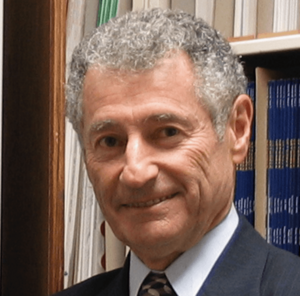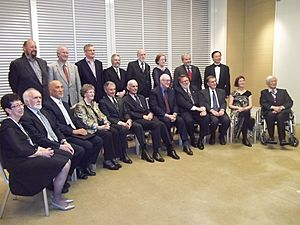Leonard Kleinrock facts for kids
Quick facts for kids
Leonard Kleinrock
|
|
|---|---|

Headshot of Leonard Kleinrock
|
|
| Born | June 13, 1934 New York City, U.S.
|
| Nationality | American |
| Alma mater | City College of New York Massachusetts Institute of Technology |
| Known for | Queueing theory, ARPANET, Internet development |
| Awards |
|
| Scientific career | |
| Fields | |
| Institutions | University of California, Los Angeles |
| Thesis |
|
| Doctoral advisor | Edward Arthurs Claude Shannon |
| Doctoral students | Chris Ferguson |
Leonard Kleinrock (born June 13, 1934) is an American computer scientist and a true Internet pioneer. He is a respected professor at UCLA, a famous university.
Kleinrock made very important discoveries in computer science. His work helped create the way computers talk to each other, which is called data communication or computer networking. He has won many big awards for his amazing contributions.
In the early 1960s, he started using a math idea called queueing theory. This helped him understand how long messages would take to travel through computer networks. His ideas were published in a book in 1964. Later, in the 1960s and 1970s, he played a key role in building the ARPANET. This was an early version of the Internet.
His work on packet switching helped make networks faster and more reliable. He also taught many students who went on to develop the Internet protocol suite. This is the set of rules that makes the Internet work today. His ideas about hierarchical routing are still very important for how the Internet operates.
Contents
Education and Early Career
Leonard Kleinrock was born in New York City on June 13, 1934. He went to a special school called the Bronx High School of Science. In 1957, he earned a degree in Electrical Engineering from the City College of New York.
He then went to the Massachusetts Institute of Technology (MIT). There, he earned his master's degree in 1959 and his Ph.D. in 1963. After that, he joined the faculty at the University of California at Los Angeles (UCLA). He even led the Computer Science Department there from 1991 to 1995.
Key Achievements in Computer Science
Understanding Network Delays with Queueing Theory
One of Kleinrock's most famous achievements is his work on queueing theory. This is a part of applied mathematics that helps understand waiting lines. Think about waiting in line at a store or for a bus. Queueing theory helps predict how long you might wait.
In 1961, Kleinrock proposed his Ph.D. research on "Information Flow in Large Communication Nets." He studied how messages moved through networks. He looked at things like how much information a network could handle and how to choose the best paths for messages. His work helped design efficient communication networks.
Building the ARPANET
In 1967, Kleinrock joined the ARPANET project. This project aimed to build a new kind of computer network. He was given a job in 1968 to set up a Network Measurement Center (NMC) at UCLA. This center would measure how well the network was working.
Kleinrock also led a team at UCLA that developed important software for the ARPANET. This software included the Network Control Program (NCP). It was like the traffic rules for the early Internet.
The First Internet Message
A very famous moment happened on October 29, 1969. A UCLA student named Charley Kline, who worked with Kleinrock, sent the first message over the ARPANET. He tried to send the word "login" from UCLA to a computer at Stanford Research Institute.
Only the letters "l" and "o" were sent before the system crashed! So, the very first message was "lo". About an hour later, they fixed the problem and successfully sent "login". This was a huge step for computer communication.
The first permanent link for ARPANET was set up on November 21, 1969, between UCLA and Stanford. By December 5, 1969, the first four-computer network was complete. Kleinrock even used the ARPANET for instant messaging from the U.S. to England in 1973. This showed how useful the network could be for everyday communication.
Developing the Modern Internet
Kleinrock wrote many research papers that helped create a whole new area of study: the theory and use of queueing theory in computer networks. He guided many students who became experts in this field.
Many of his students went on to work on internetworking and the Internet protocol suite. These are the core technologies that make the Internet work today. His research in the 1970s helped develop the Transmission Control Protocol (TCP), which is a key part of the Internet's rules. His ideas about hierarchical routing are still vital for how the Internet finds its way around.
In 1988, Kleinrock led a group that told the U.S. Congress that a "national research network" was urgently needed. This report helped Al Gore push for the High Performance Computing Act of 1991. This law provided funding that helped the Internet grow into what we know today. This funding also helped create the Mosaic web browser in 1993, which made the World Wide Web popular.
Awards and Recognition
Leonard Kleinrock has received many important awards for his work. In 1980, he became a member of the National Academy of Engineering. This was for his pioneering work and for teaching others about computer networks.
In 2001, he received the Draper Prize for his role in developing the Internet. In 2008, he was given the National Medal of Science. This is the highest science honor in the U.S. President George W. Bush presented it to him. The award recognized his "fundamental contributions to the mathematical theory of modern data networks, and for the functional specification of packet switching, which is the foundation of Internet technology." It also praised him for teaching many students who helped bring these technologies to the world.
In 2010, he shared the Dan David Prize. UCLA even restored Room 3420 in Boelter Hall to look like it did in 1969. It is now called the Kleinrock Internet Heritage Site and Archive. It opened in 2011, with many Internet pioneers attending.
In 2012, Kleinrock was added to the Internet Hall of Fame. He was also recognized as an Eminent Member of IEEE-Eta Kappa Nu in 2011. This is the highest honor from that organization. In 2014, he received the BBVA Foundation Frontiers of Knowledge Award for his "seminal contributions to the theory and practical development of the Internet."
In 2014, a special edition of the Computer Networks journal was published in his honor. It featured articles celebrating his contributions to queueing theory, packet switching, computer networks, and the Internet.
See also
 In Spanish: Leonard Kleinrock para niños
In Spanish: Leonard Kleinrock para niños


